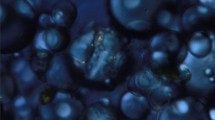Abstract
The photosensitizing activity of curcumin was tested in corn oil and oil-in-water (O/W) emulsion systems under visible light irradiation. In addition, the antioxidative/prooxidative properties of curcumin were evaluated in corn oil at 100 °C and in O/W emulsion at room temperature under riboflavin photosensitization or at 60 °C in the dark. Curcumin acted as a photosensitizer in corn oil and O/W emulsions . The oxidative stability of corn oil samples containing curcumin (0–5.0 mmol/kg oil) were not significantly different (p > 0.05) at 100 °C, implying curcumin did not act as an antioxidant nor a prooxidant in corn oil. However, curcumin inhibited lipid oxidation in O/W emulsions under riboflavin photosensitization at room temperature and 60 °C in the dark. The photosensitization and antioxidant abilities of curcumin were greatly influenced by matrix types and presence of riboflavin. Therefore, antioxidative or prooxidative characteristics of curcumin should be evaluated considering matrix type including bulk oil or O/W emulsions and presence of visible light irradiation.




Similar content being viewed by others
References
Pari L, Tewas D, Eckel J (2008) Role of curcumin in health and disease. Arch Physiol Biochem 114:127–149
Menon VP, Sudheer AR (2007) Antioxidant and anti-inflammatory properties of curcumin. Adv Exp Med Biol 595:105–125
Jovanovic SV, Steenken S, Boone CW, Simic MG (1999) H-atom transfer is a preferred antioxidant mechanism of curcumin. J Am Chem Soc 121:9677–9981
Ak T, Gülçin İ (2008) Antioxidant and radical scavenging properties of curcumin. Chem Biol Interact 174:27–37
Crivello JV, Bulut U (2005) Curcumin: a naturally occurring long-wavelength photosensitizer for diaryliodonium salts. J Polym Sci 43:5217–5231
Banerjee A, Kunwar A, Mishra B, Priyadarsini KI (2008) Concentration dependent antioxidant/pro-oxidant activity of curcumin studies from AAPH induced hemolysis of RBCs. Chem Biol Interact 174:134–139
Chaiyasit W, Elias RJ, McClements DJ, Decker EA (2007) Role of physical structures in bulk oils on lipid oxidation. Crit Rev Food Sci Nutr 47:299–317
Chaiyasit W, McClements DJ, Decker EA (2000) The relationship between the physicochemical properties of antioxidants and their ability to inhibit lipid oxidation in bulk oil and oil-in-water emulsions. J Agric Food Chem 53:4982–4988
Schwarz K, Huang SW, German JB, Tiersch B, Hartmann J, Frankel EN (2000) Activities of antioxidants are affected by colloidal properties of oil-in-water and water-in-oil emulsions and bulk oils. J Agric Food Chem 48:4874–4882
Kim TS, Decker EA, Lee JH (2012) Antioxidant capacities of α-tocopherol, trolox, ascorbic acid, and ascorbyl palmitate in riboflavin photosensitized O/W emulsion systems. Food Chem 133:68–75
Ha DO, Park CU, Kim MJ, Lee JH (2012) Antioxidative and prooxidative activity of β-carotene in thermally-oxidized and photosensitized lard model systems. Food Sci Biotechnol 21:607–611
Park JW, Kim TS, Kim MJ, Lee JH (2013) Prooxidative and antioxidative properties of β-carotene in chlorophyll and riboflavin photosensitized oil-in-water emulsions. Food Chem 140:255–261
Min DB, Boff JM (2002) Chemistry and reaction of singlet oxygen in foods. Comp Rev Food Sci F 1:58–72
Lee JH, Decker EA (2011) Effects of metal chelators, sodium azide, and superoxide dismutase (SOD) on the oxidative stability in riboflavin photosensitized O/W emulsion systems. J Agric Food Chem 59:6271–6276
American Oil Chemists’ Society (AOCS) (2006) Official and recommended practices of the American Oil Chemist’s Society, 4th edn, AOCS Champaign
Priyadarsini KI (2009) Photophysics, photochemistry and photobiology of curcumin: studies from organic solutions, bio-mimetics and living cells. J Photoch Photobio C 10:81–95
Chignell CF, Bilski P, Reszka KJ, Motten AG, Sik RH, Dahl TA (1994) Spectral and photochemical properties of curcumin. Photochem Photobiol 59:295–302
Yang SO, Chang PS, Lee JH (2005) Effects of riboflavin-photosensitized oxidation on the formation of volatile compounds in oleic acid model systems. Korean J Food Sci Technol 37:717–722
Foote CS (1976) Photosensitized oxidation and singlet oxygen: consequences in biological systems. In: Pryor WA (ed) Free radicals in biology. Academic Press, New York, pp 85–133
Gorman AA, Hamblett I, Srinavasan VS, Wood PD (1994) Curcumin-derived transients: a pulsed laser and pulse radiolysis study. Photochem Photobiol 59:389–398
Acknowledgments
This work was supported by the National Research Foundation of Korea (NRF) grant funded by the Korea government (MSIP) (No. 2013R1A2A2A01067293) and (No. 2014R1A2A1A11050047).
Author information
Authors and Affiliations
Corresponding author
About this article
Cite this article
Yi, B., Ka, H.J., Kim, MJ. et al. Effects of Curcumin on the Oxidative Stability of Oils Depending on Type of Matrix, Photosensitizers, and Temperature. J Am Oil Chem Soc 92, 685–691 (2015). https://doi.org/10.1007/s11746-015-2639-y
Received:
Revised:
Accepted:
Published:
Issue Date:
DOI: https://doi.org/10.1007/s11746-015-2639-y




